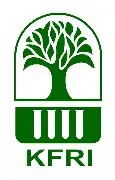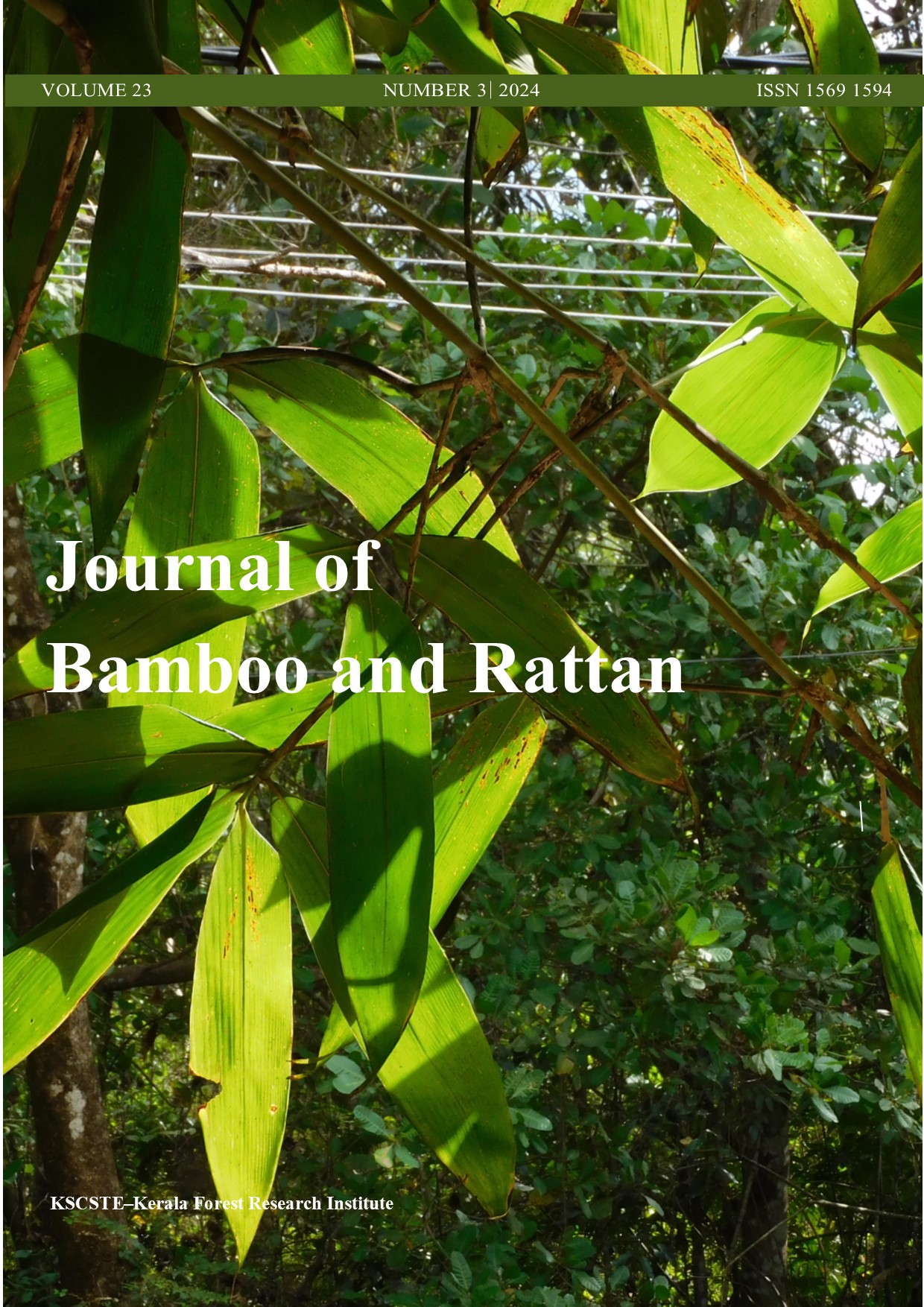Ethnographic exploration and documentation of Kannadippaya (Bamboo reed mat) weaving among tribal communities in Kerala
DOI:
https://doi.org/10.55899/09734449/jbr023302Keywords:
Kannadippaya, bamboo mat weaving, traditional ecological knowledge (TEK), tribal communitiesAbstract
The weaving practices of traditional Kannadippaya (bamboo reed mat) among tribal communities in Kerala, India, are explored in this study. Data was collected between 2021 and 2023 with an ethnographic approach along with exploratory design, employing methods such as participant observation, in-depth interviews, focus group discussions, document analysis and visual ethnography. With the tradition being one not studied before; key informants were identified using the snowball sampling method. The research aims to document the traditional knowledge and techniques of weaving bamboo mats, the preferred bamboo species, and the socio-economic implications of the craft. The study investigates the current challenges faced by weavers, including resource depletion, economic constraints, and the waning interest of younger generations. It also analyses the role of government and non-governmental organizations in supporting this traditional craft. The findings underscore the cultural significance of Kannadippaya weaving and emphasize the urgent need for interventions to preserve and promote this intangible heritage.
References
Beena, V.B. 2011. Reproductive biology and biochemical changes associated with the flowering of Dendrocalamus stocksii and Ochlandra travancorica. PhD Thesis,
Berkes, F. 2018. Sacred Ecology, 4th edition. Abingdon: Routledge. Pp 23-27
Bourdillon, T.F. 1893. Report on the Forests of Travancore, Government Press, Trivandrum.
Buell, M. C., Ritchie, D., Ryan, K., and Metcalfe, C. D. 2020. Using Indigenous and Western knowledge systems for environmental risk assessment. Ecological Applications, 30(7), e02146. https://doi.org/10.1002/eap.2146
Chandrashekara, U. M., Tikhile, P., Subbanna, S., & Viswanath, S. 2019. Socio-cultural and management significance of bamboos in Indian heritage and tradition. Journal of Bamboo and Rattan, Vol. 18, Nos. 4, pp. 63 - 72
Gopakumar, B., and Motwani, B. 2013. Factors restraining the natural regeneration of reed bamboo Ochlandra travancorica and O. wightii in Western Ghats, India. Journal of Tropical Forest Science, 250-258.
Hill, R., Adem, Ç., Alangui, W. V., Molnár, Z., Aumeeruddy-Thomas, Y., Bridgewater, P., ... and Xue, D. 2020. Working with indigenous, local, and scientific knowledge in assessments of nature and nature’s linkages with people. Current Opinion in Environmental Sustainability 43: pp. 8–20. https://doi.org/10.1016/j.cosust.2019.12.006
Johnson, J. T., Howitt, R., Cajete, G., Berkes, F., Louis, R. P., and Kliskey, A. 2016. Weaving Indigenous and sustainability sciences to diversify our methods. Sustainability Science, 11, 1-11. https://doi.org/10.1007/s11625-015-0349-x
Koshy, K. C. 2011. Final report on Bamboo and Reed Resource Enhancement in Kerala of the R & D project submitted to The Western Ghats Cell Planning and Economic Affairs Department Government of Kerala, India.
Kumar, M. 2011. Bamboos of peninsular India: all India coordinated project on taxonomy (AICOPTAX): Grasses and Bamboos Part-II. Art options, New Delhi.
Molnár, Z., and Babai, D. 2021. Inviting ecologists to delve deeper into traditional ecological knowledge. Trends in Ecology & Evolution, 36(8): 679–690.
Narayanan, M. 2023. Following “Fibreality”: What Does the Making of Bamboo Baskets Tell Us? ICON: Journal of the International Committee for the History of Technology, 28(2), 105-127.
Pavithra, G. M., and Jacob, K. J. 2018. Building a successful Bamboo based Community: A case study of Kerala State Bamboo Corporation Limited, Kerala, India, Journal of Bamboo and Rattan, vol. 17, No 2. pp 26- 35
Raghu, A. V., and Viswanath, S. 2021. ‘Kannadipaya’ – role of geographical indication in brand- making and conservation, Current Science, vol. 120.
Rao, R.R. and Hajra, P.K. 1987. Methods and research in Ethnobotany, In: A manual of Ethnobotany, edited by S.K. Jain, (Society of ethnobotanist), Veer Printing Press, Lucknow, 33-41.
Sharma, M. L., and Nirmala, C. 2015. Bamboo diversity of India: an update. In Proceedings of the 10th World Bamboo Congress, Damyang, Korea. pp. 17-22.
Singleton, B. E., Gillette, M. B., Burman, A., and Green, C. 2023. Toward productive complicity: Applying ‘traditional ecological knowledge’ in environmental science. The Anthropocene Review, 10(2), 393–414. https://doi.org/10.1177/20530196211057026
Sinthumule N.I. 2023. Traditional ecological knowledge and its role in biodiversity conservation: a systematic review. Frontiers in Environmental Science, 11, 1164900. doi: 10.3389/fenvs.2023.1164900
Downloads
Published
Issue
Section
License
Copyright (c) 2025 Journal of Bamboo and Rattan

This work is licensed under a Creative Commons Attribution-NonCommercial-ShareAlike 4.0 International License.
How to Cite
Most read articles by the same author(s)
- Krishnapriya K R , Sreekumar V. B., Syam Viswanath, Physical and anatomical variations in culm characteristics of Pseudoxytenanthera bourdillonii (Gamble) H.B.Naithani – a lesser studied endemic bamboo in the Western Ghats, Kerala , Journal of Bamboo and Rattan: Vol. 23 (2024): Issue 2
Similar Articles
- Jithu Unni Krishnan, Prabhat Kumar, Sreekumar V.B., Surya Narayanan G.K., Bheemalingappa M., In-Vitro Assessment of Host Suitability of Thirty-One Bamboo Species to the Invasive Polyphagous Pest Spodoptera frugiperda (J.E. Smith) (Lepidoptera: Noctuidae) , Journal of Bamboo and Rattan: Vol. 23 (2024): Issue 4
- E. Appiah-Kubi, F. W. Owusu, S. L. Tekpetey , C. Essien, Bamboo for housing in Ghana: challenges and prospects for the future , Journal of Bamboo and Rattan: Vol. 13 (2014): Issue 3 & 4
- Shweta B. Kukreti, Aswathi Rajeev, Review on bamboo treatment in India: A species-specific approach for enhanced durability , Journal of Bamboo and Rattan: Vol. 23 (2024): Issue 1
- E. Appiah-Kubi, F.W. Owusu, S. L. Tekpetey, C. Essien, H. Seidu , Investigating the mechanical properties of some bamboo species for efficient utilization in Ghana , Journal of Bamboo and Rattan: Vol. 13 (2014): Issue 3 & 4
- Sadananda Chingangbam, L.B. Singha, O.P. Tripathi, S. Dilip, K. Premkumar, C. Lulloo, Estimation of lesser known anti-nutrients; Phytic acid and Trypsin inhibitor from the edible bamboo shoots and their processed products of Arunachal Pradesh, India , Journal of Bamboo and Rattan: Vol. 22 (2023): Issue 1
- K. Sijimol, Suma Arun Dev, E. M. Muralidharan, V. B. Sreekumar, DNA barcoding: An emerging tool for precise identification and certification of planting stock in taxonomically challenging bamboo species , Journal of Bamboo and Rattan: Vol. 13 (2014): Issue 1 & 2
- Abraham Ayamga-Annia, Jonny Osei Kofi, Charles Antwi Boasiako, Investigation of the bond between bamboo and ribbed steel reinforcements and the surrounding concrete by pull-out test , Journal of Bamboo and Rattan: Vol. 22 (2023): Issue 4
- Manish Sakhlecha, Samir Bajpai, Rahul Ralegaonkar, Badrinarayan Rath, Rahul Datta, Rebuilding a traditional village house using the carbon footprint approach , Journal of Bamboo and Rattan: Vol. 22 (2023): Issue 2
- Thiti Wanishdilokratn, Jirapa Wanishdilokratn, Physical and mechanical properties of Dendrocalamus giganteus from difference zones in Long district, Phrae province, Thailand , Journal of Bamboo and Rattan: Vol. 23 (2024): Issue 2
- G. E Pereira, K. L. Santos, D. C. Ortiz, M. P. Guerra, L. R. Topanotti, Potential bamboo species for cultivation in the southern plateau of Atlantic Forest, Brazil , Journal of Bamboo and Rattan: Vol. 23 (2024): Issue 4
You may also start an advanced similarity search for this article.

